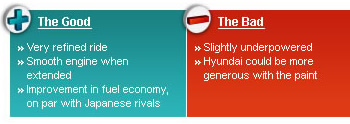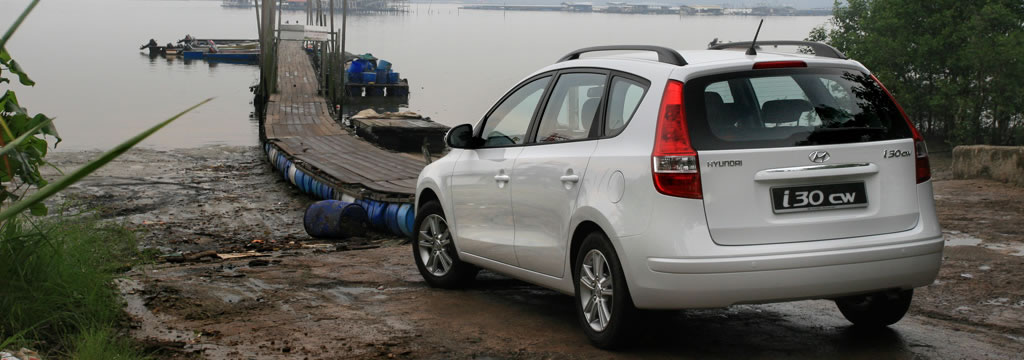Hyundai i30 Wagon 1.6 Sunroof (A) Review
14 Jul 2009|34,186 views
 |
But rather than contend with its sister brand, the i30 has chosen to branch out in a more sophisticated, family-like fashion.
Obviously based on a longer platform of the Kia Cee'd and the original i30, the CW is aimed towards the Matrix-esque crowd looking for a family 5-door, automobile.
Compared to the standard i30, it's a whopping 230 mm longer overall, with the bulk of the increase going to its backside aft of the rear axle. Theoretically, you'd be able to slot in 18 more centimetres of cargo back there alone even when inspected visually.
The car also looks different, if you pay attention to the C-pillar that is. Unfortunately, the tailgate has also been restyled. Gone are the sexy elongated tail lamps and that recessed tailgate that really screamed BMW 1-Series. In its place is a more conventional, squarish-looking design.
But fret not - the rest of it is rather similar. There's that handsome chrome blade across the air intake grille, and its Mazda rivaling side profile is striking enough to set it above the generic backpacking crowd.
Interior
Since the debut of the Getz, Avante, and the face-lifted Hyundai Tuscani, we've seen the overall quality of Hyundai's cars improve dramatically. The i30 is yet another step up equaling or bettering many 1.6-litre Japanese rivals out there.
 |
There's a sunroof, leather seats with quality stitching, a chiller-glove compartment, iPod connectivity (option), fog lights, trip computer, immobilizer, proper chrome detailing, quality soft-touch materials, curtain airbags, ESP and brake assist.
The seats feature a full range of adjustability for most Asian and European drivers, but unlike the standard i30, the steering column now adjusts only for tilt. At the back, there's a slight improvement in legroom, while your cargo can now be hidden and held in place with a cargo net and luggage cover in true station-wagon style.
Driving Impressions
The i30 CW comes only with the 1.6-litre petrol engine with 122 bhp at 6,200 rpm and 154 Nm at 4,200 rpm. The CVVT (continuously variable valve timing) block is quite the thing in keeping with the times, adopting the position of its extractors being placed behind the engine, facing the back of the car.
While we previously clocked the standard i30's 0-100km/h sprint in 10.97 seconds, the heavier i30 CW was a full second slower when launched in a similar fashion. No surprises there, thanks to its ample posterior.
But that's just a minor setback. Refinement is still the CW's forte. The cabin remains as silent as that of a Camry, all the way past legal speed limits. There's a little rustling behind the C-pillars, but otherwise there's very little road noise from the 185/65 R15 tyres.
While we were not able to obtain exacting weight figures of both cars, the i30 CW did feel like the heavier car when attempts to shift its weight around corners were made.
But the weight increase was in the right place, and as a result, the car felt well-balanced, with enough steering feel and accuracy to feel through hazardous patches in the rain. Don't push it too far though - those stock tyres don't hold up for much when you get rough with it.
The interesting thing about the i30 wagon is that the rear end will push itself out quite a fair bit, again, making it fun to drive, but this can be a little dangerous when you take things too far. It all reminds me of a MINI that has been bloated up by four times its weight - a compliment for any car of this size, no doubt.
The progressive controls meant that it was easy to create a good flow when driven enthusiastically, further complimenting the Hyundai's electrically-assisted power steering.
Like the standard i30, the CW clocked around 10km/litre average from a day's worth of hard driving.
Is it worth it?
The wagon currently retails for $4,000 more than the basic 1.6 GLS 5-door automatic. That's also $2,400 more than the up-specified standard i30. As such, you'll loose the bigger sports rims and a few minor luxury items. But you do get much more boot space, especially if you're a family of four, or even five.
We've said this before, and we're going to say it again - the Hyundai i30 is more than a worthy competitor to popular choices such as the Toyota Corolla, Mitsubishi Lancer and Mazda 3. It's built really well, is utterly refined, and judging from Hyundais of past, will yield no major problems during the course of its service life.
Furthermore, for the price, you're looking at cars such as the quirky Daihatsu Materia and Terios, Chevrolet Optra Estate, the Suzuki APV and the positively European Skoda Roomster. And for $60,599, it's going to be a hard fight for its competitors to surpass its price-quality ratio.
 |
But rather than contend with its sister brand, the i30 has chosen to branch out in a more sophisticated, family-like fashion.
Obviously based on a longer platform of the Kia Cee'd and the original i30, the CW is aimed towards the Matrix-esque crowd looking for a family 5-door, automobile.
Compared to the standard i30, it's a whopping 230 mm longer overall, with the bulk of the increase going to its backside aft of the rear axle. Theoretically, you'd be able to slot in 18 more centimetres of cargo back there alone even when inspected visually.
The car also looks different, if you pay attention to the C-pillar that is. Unfortunately, the tailgate has also been restyled. Gone are the sexy elongated tail lamps and that recessed tailgate that really screamed BMW 1-Series. In its place is a more conventional, squarish-looking design.
But fret not - the rest of it is rather similar. There's that handsome chrome blade across the air intake grille, and its Mazda rivaling side profile is striking enough to set it above the generic backpacking crowd.
Interior
Since the debut of the Getz, Avante, and the face-lifted Hyundai Tuscani, we've seen the overall quality of Hyundai's cars improve dramatically. The i30 is yet another step up equaling or bettering many 1.6-litre Japanese rivals out there.
 |
There's a sunroof, leather seats with quality stitching, a chiller-glove compartment, iPod connectivity (option), fog lights, trip computer, immobilizer, proper chrome detailing, quality soft-touch materials, curtain airbags, ESP and brake assist.
The seats feature a full range of adjustability for most Asian and European drivers, but unlike the standard i30, the steering column now adjusts only for tilt. At the back, there's a slight improvement in legroom, while your cargo can now be hidden and held in place with a cargo net and luggage cover in true station-wagon style.
Driving Impressions
The i30 CW comes only with the 1.6-litre petrol engine with 122 bhp at 6,200 rpm and 154 Nm at 4,200 rpm. The CVVT (continuously variable valve timing) block is quite the thing in keeping with the times, adopting the position of its extractors being placed behind the engine, facing the back of the car.
While we previously clocked the standard i30's 0-100km/h sprint in 10.97 seconds, the heavier i30 CW was a full second slower when launched in a similar fashion. No surprises there, thanks to its ample posterior.
But that's just a minor setback. Refinement is still the CW's forte. The cabin remains as silent as that of a Camry, all the way past legal speed limits. There's a little rustling behind the C-pillars, but otherwise there's very little road noise from the 185/65 R15 tyres.
While we were not able to obtain exacting weight figures of both cars, the i30 CW did feel like the heavier car when attempts to shift its weight around corners were made.
But the weight increase was in the right place, and as a result, the car felt well-balanced, with enough steering feel and accuracy to feel through hazardous patches in the rain. Don't push it too far though - those stock tyres don't hold up for much when you get rough with it.
The interesting thing about the i30 wagon is that the rear end will push itself out quite a fair bit, again, making it fun to drive, but this can be a little dangerous when you take things too far. It all reminds me of a MINI that has been bloated up by four times its weight - a compliment for any car of this size, no doubt.
The progressive controls meant that it was easy to create a good flow when driven enthusiastically, further complimenting the Hyundai's electrically-assisted power steering.
Like the standard i30, the CW clocked around 10km/litre average from a day's worth of hard driving.
Is it worth it?
The wagon currently retails for $4,000 more than the basic 1.6 GLS 5-door automatic. That's also $2,400 more than the up-specified standard i30. As such, you'll loose the bigger sports rims and a few minor luxury items. But you do get much more boot space, especially if you're a family of four, or even five.
We've said this before, and we're going to say it again - the Hyundai i30 is more than a worthy competitor to popular choices such as the Toyota Corolla, Mitsubishi Lancer and Mazda 3. It's built really well, is utterly refined, and judging from Hyundais of past, will yield no major problems during the course of its service life.
Furthermore, for the price, you're looking at cars such as the quirky Daihatsu Materia and Terios, Chevrolet Optra Estate, the Suzuki APV and the positively European Skoda Roomster. And for $60,599, it's going to be a hard fight for its competitors to surpass its price-quality ratio.
Car Information
Hyundai i30 1.6 GLS 5dr (A)
CAT A|Petrol|14.5km/L
Horsepower
91kW (122 bhp)
Torque
154 Nm
Acceleration
10.9sec (0-100km /hr)
This model is no longer being sold by local distributor
All Used Hyundai i30Thank You For Your Subscription.



































